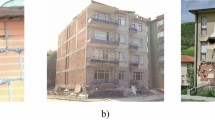Abstract
Uplift of certain abutment bearings during earthquake may be utilized as a safety mechanism for the protection of the bridge against excessive stress. For this reason design codes such as Eurocode 8 permit the uplift of such bearings under certain conditions. Uplift of an abutment bearing occurs when the torque at the deck end exceeds a critical value. Therefore the torsional stiffness of the deck, before or after concrete cracking, is an important factor. In this work realistic values for the cracked torsional stiffness of the bridge deck are estimated from a parametric study of typical thin-walled prestressed box girders, based on non-linear analysis of softened space truss models proposed in the literature. Moreover the interaction between bearing uplift and pier flexural response is investigated and recommendations for the seismic design of bridges are proposed, taking into account the possibility of uplift of abutment bearings before or after yielding of the piers.
Similar content being viewed by others
References
Batchelor B, McEwen D (1977) Eccentrically prestressed box girders under combined bending and torsion. ACI J Proc 74(4): 156–162
Fu CC, Tang Y (2001) Torsional analysis for prestressed concrete multiple cell box. J Eng Mech 127(1): 45–51. doi:10.1061/(ASCE)0733-9399
Hsu TTC (1991) Nonlinear analysis of concrete torsional members. ACI Struct J 88(6): 674–682
Hsu TTC, Mo YL (1985a) Softening of concrete in torsional members—theory and tests. ACI J Proc 82(3): 290–303
Hsu TTC, Mo YL (1985b) Softening of concrete in torsional members—design recommendations. ACI J Proc 82(4): 290–303
Hsu TTC, Mo YL (1985c) Softening of concrete in torsional members—prestressed concrete. ACI J Proc 82(5): 290–303
Marti P, Meyboom J (1992) Response of prestressed concrete elements to in-plane shear forces. ACI Struct J 89(5): 503–514
McGee D, Zia P (1976) Prestressed concrete under torsion shear and bending. ACI J Proc 73(1): 26–32
Mukhopadhyay M, Roy SK (1979) Pure torsion of prestressed flanged sections. Build Environ 14: 135–146. doi:10.1016/0360-1323(79)90019-2
Rahal KN, Collins MP (1996) Simple model for predicting torsional strength of reinforced and prestressed concrete sections. ACI Struct J 93(6): 658–666
Timoshenko S, Goodier JN (1951) Theory of elasticity (2nd edn). McGraw Hill
Vecchio F, Collins MP (1981) Stress–strain characteristics of reinforced concrete in pure shear. Final report of International Association of Bridge and Structural Engineering (IABSE) colloquium on advanced mechanics of reinforced Concrete, pp 211–225
Vecchio F, Collins MP (1986) The modified compression-field theory for reinforced concrete elements subjected to shear. ACI J Proc 83: 219–231
Wafa FF, Shihata SA, Ashour SA, Akhtaruzzaman AA (1995) Prestressed high-strength concrete beams under torsion. J Struct Eng 121(9): 1280–1286. doi:10.1061/(ASCE)0733-9445
Author information
Authors and Affiliations
Corresponding author
Rights and permissions
About this article
Cite this article
Katsaras, C.P., Panagiotakos, T.B. & Kolias, B. Effect of torsional stiffness of prestressed concrete box girders and uplift of abutment bearings on seismic performance of bridges. Bull Earthquake Eng 7, 363–375 (2009). https://doi.org/10.1007/s10518-008-9071-8
Received:
Accepted:
Published:
Issue Date:
DOI: https://doi.org/10.1007/s10518-008-9071-8




